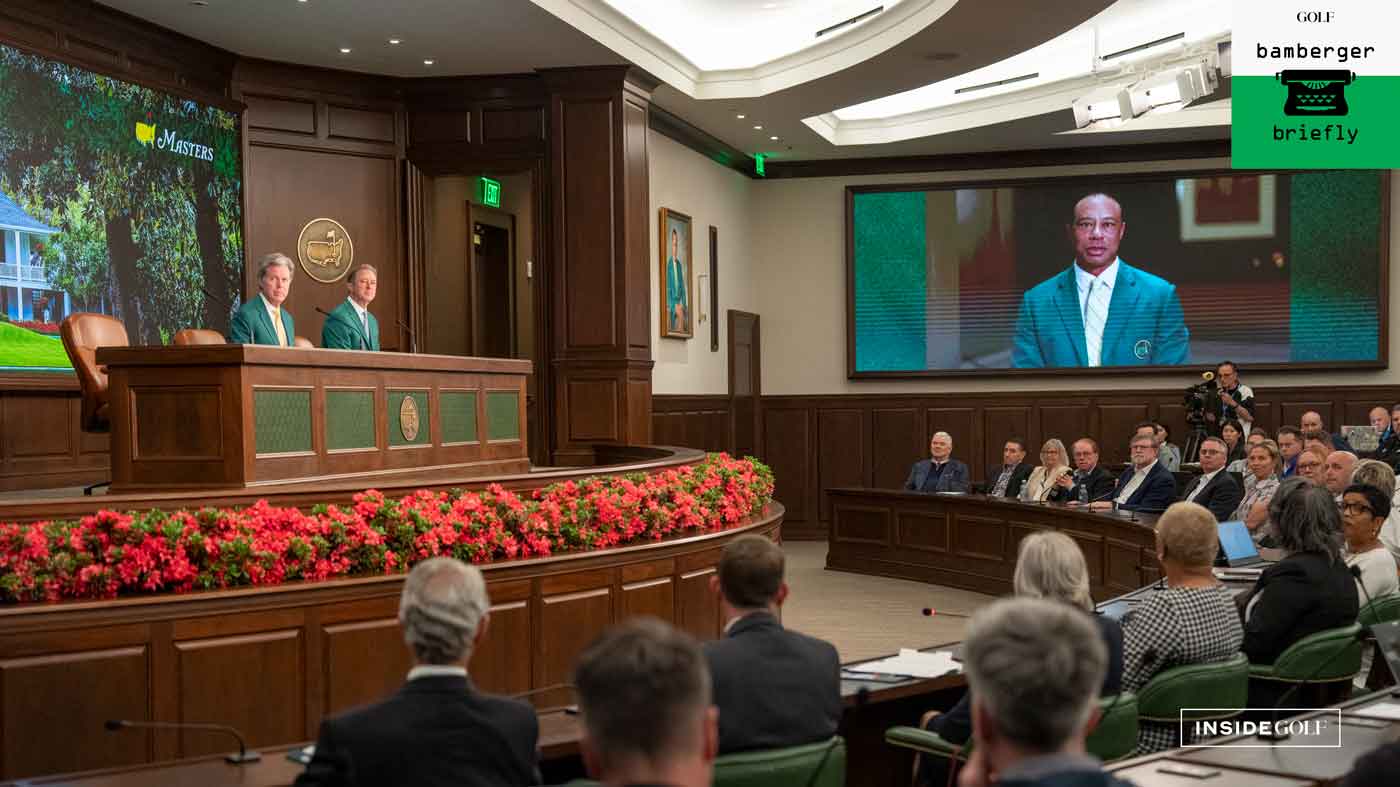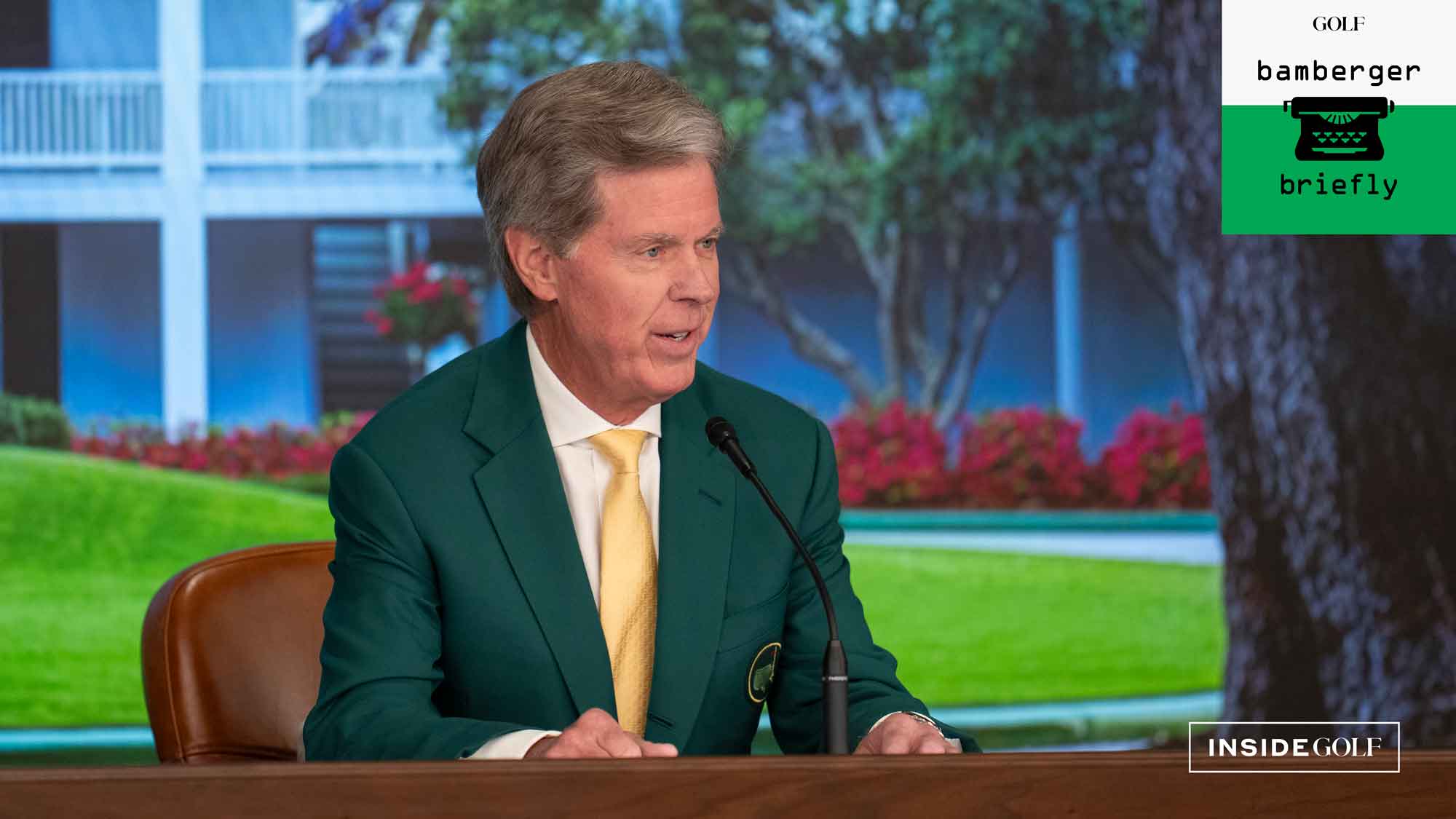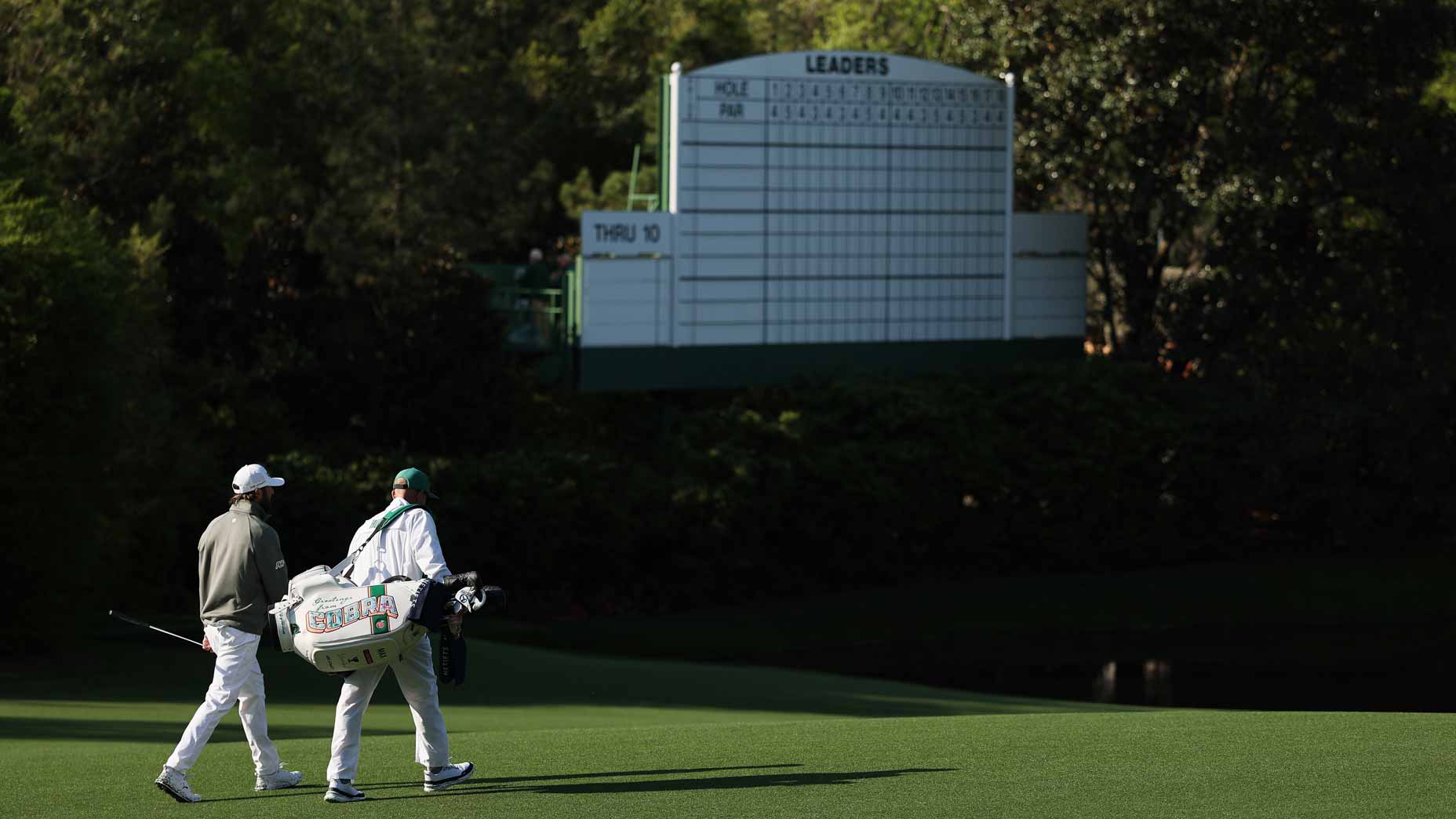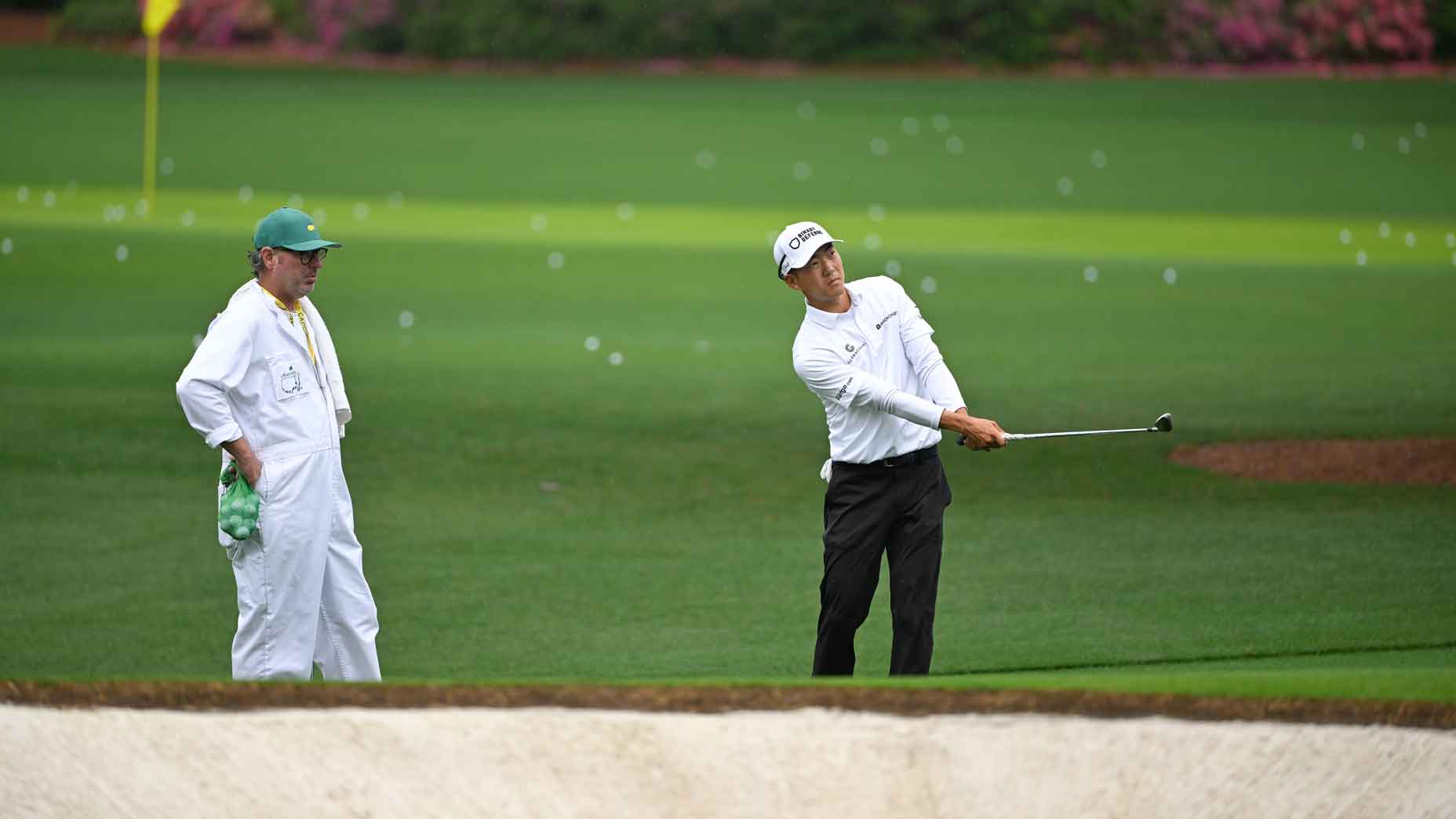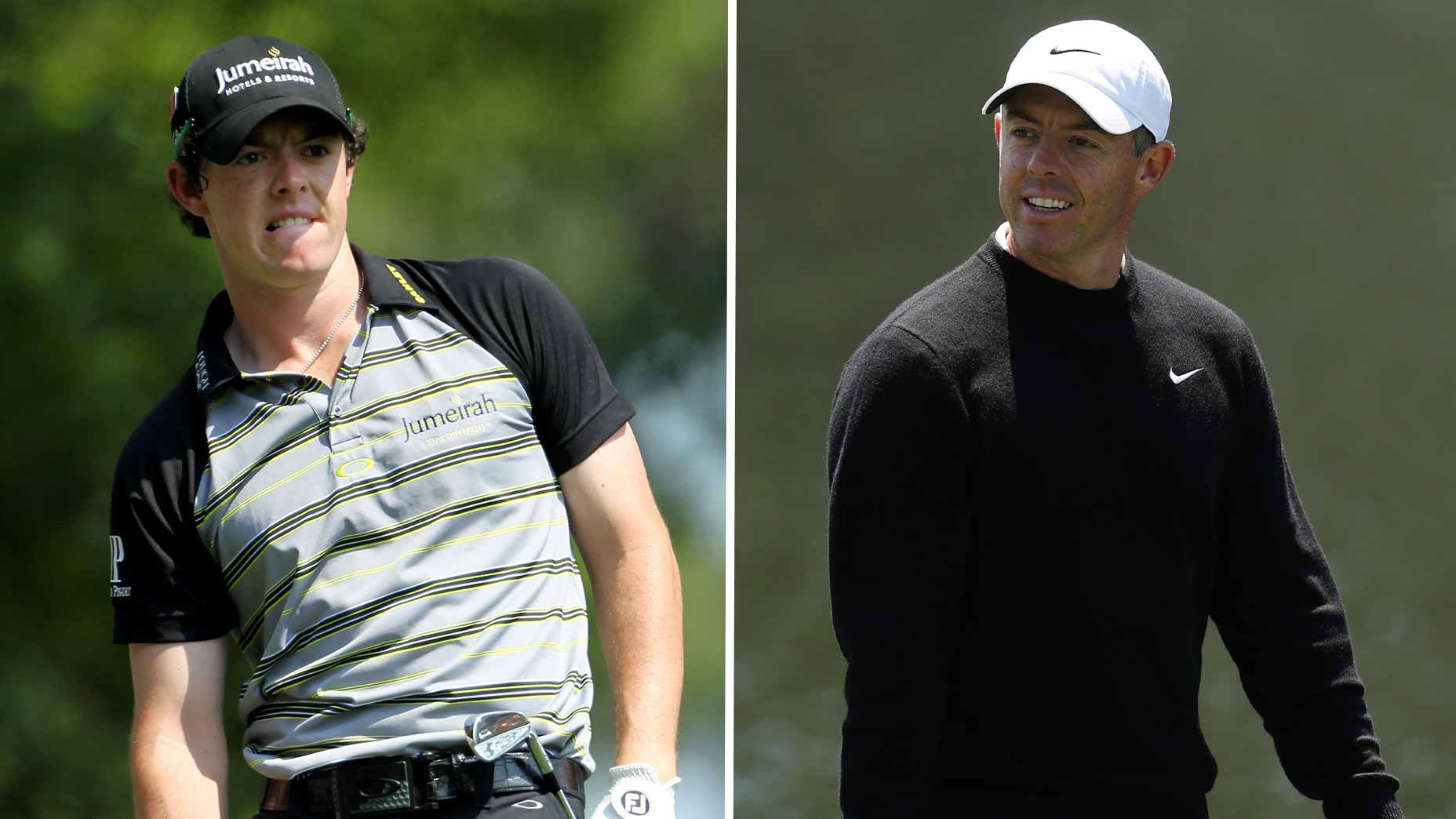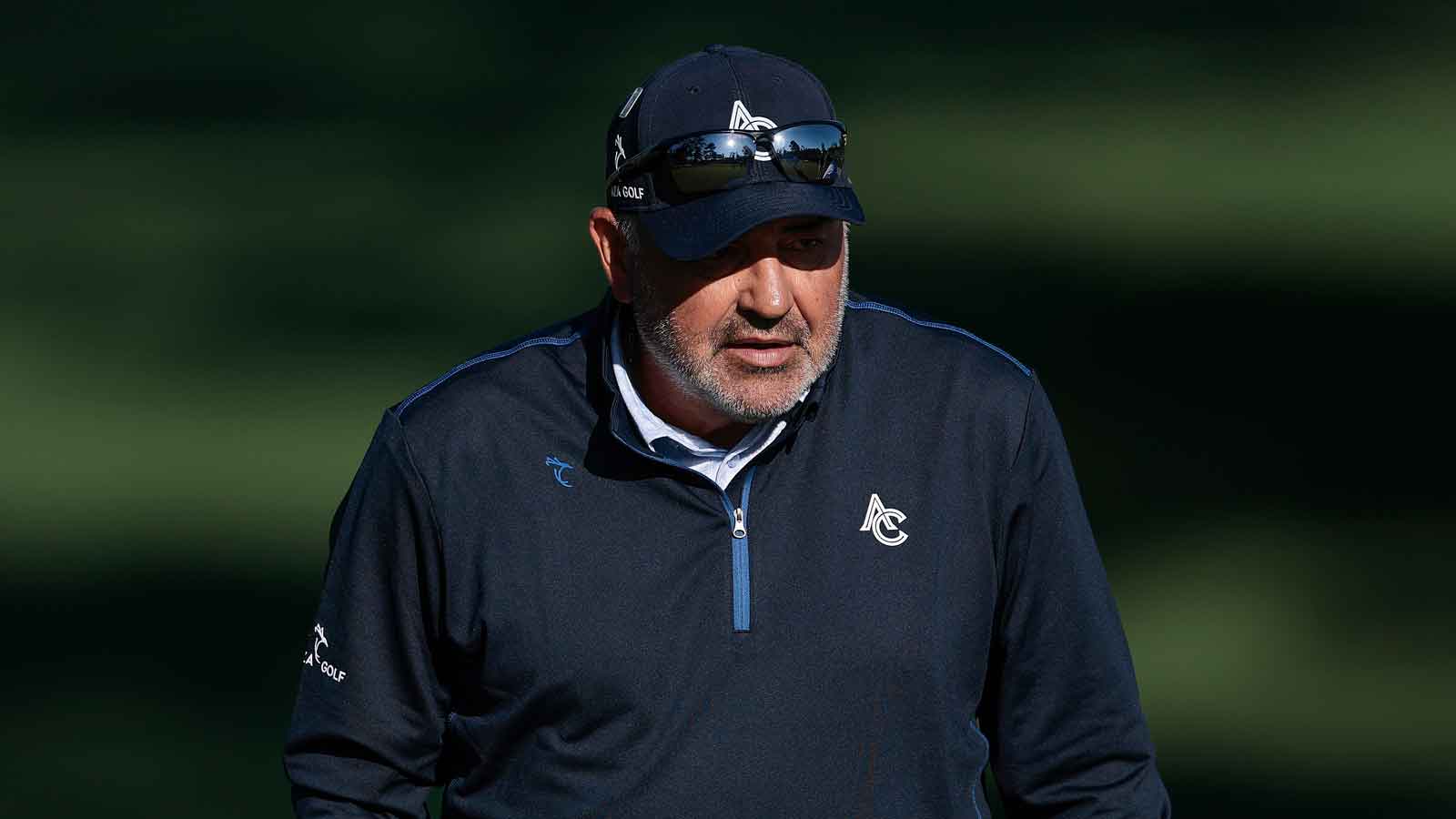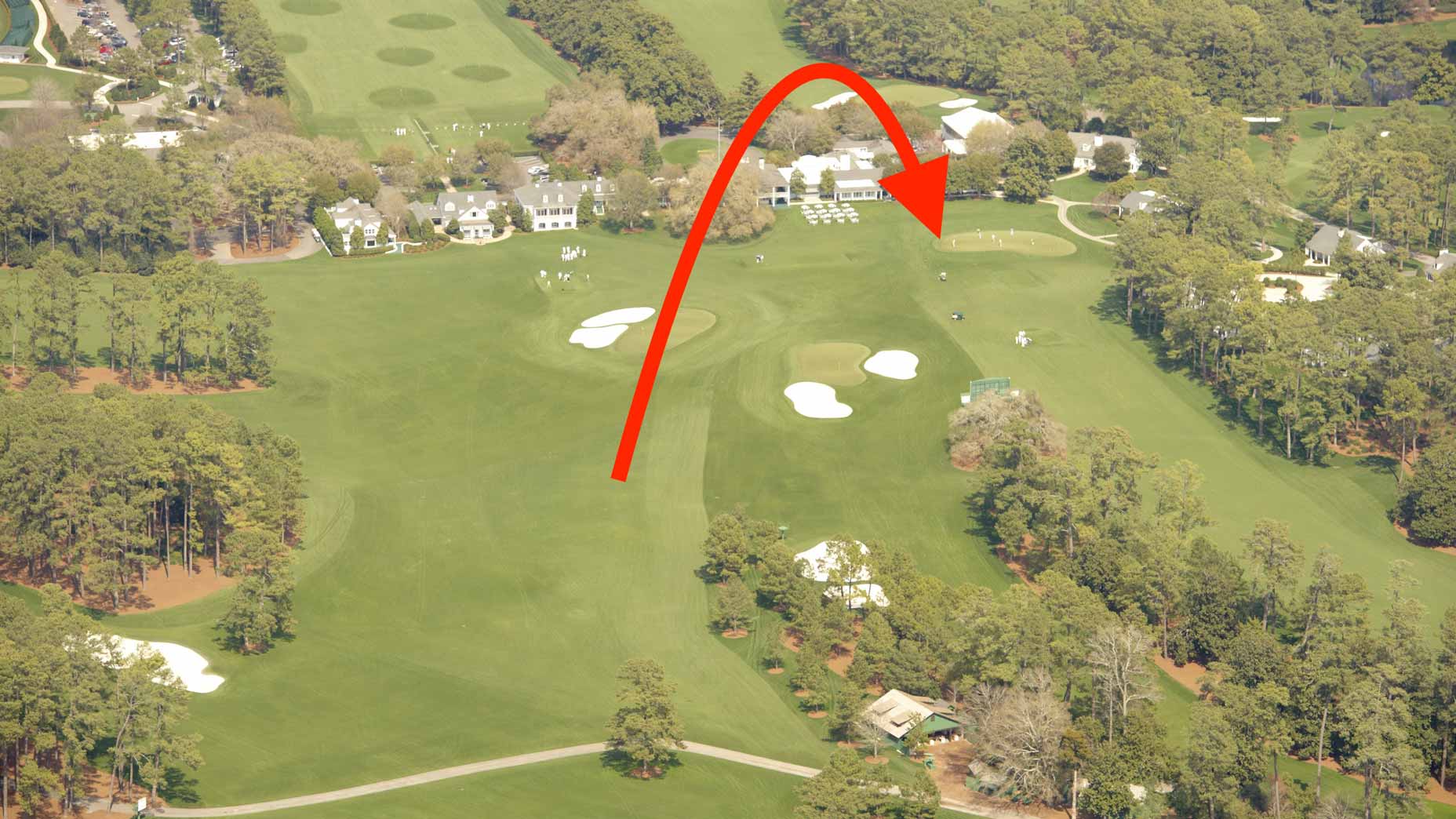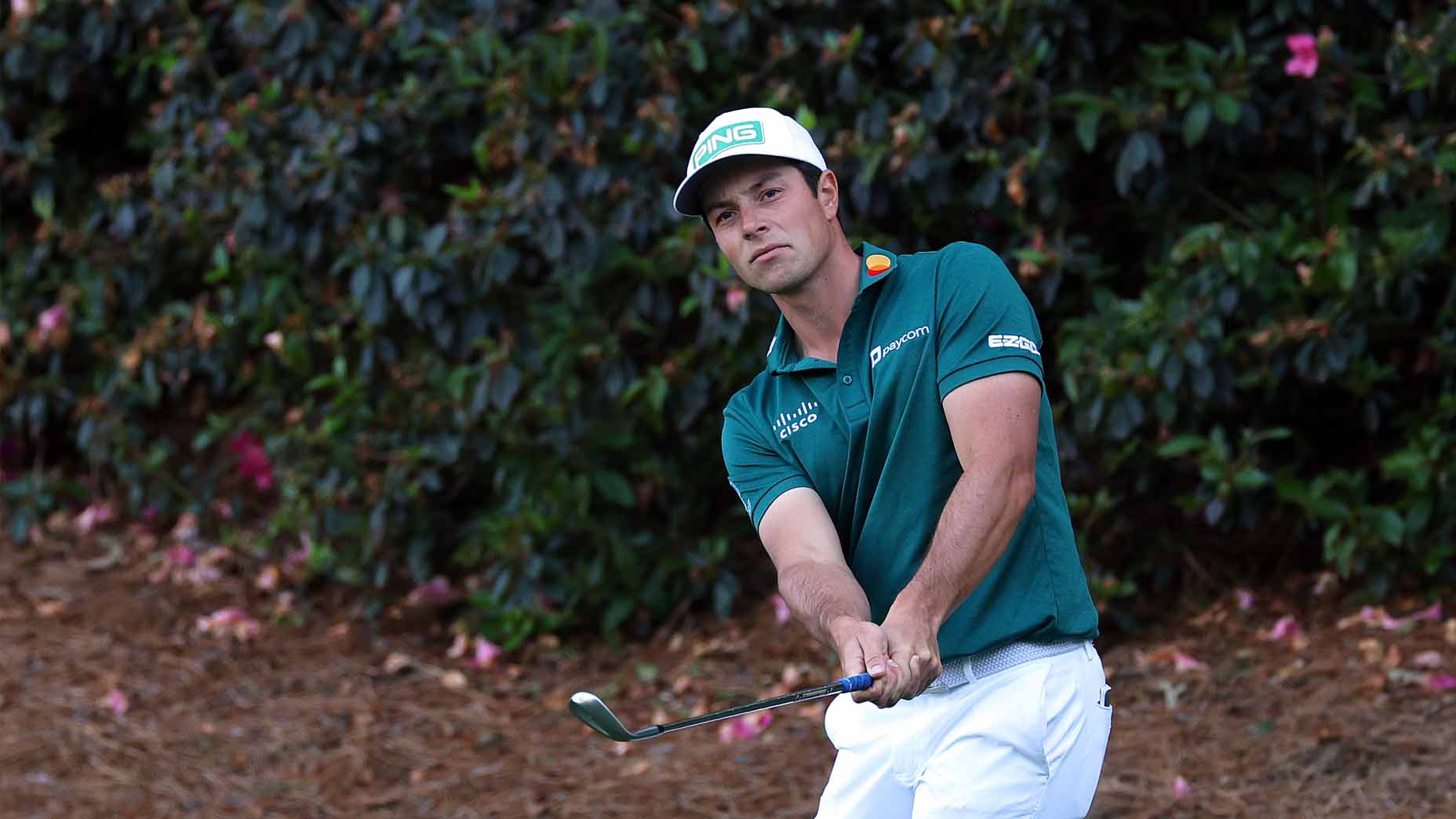Nick Piastowski
Rory McIlroy hits a shot as Scottie Scheffler looks on at last year’s Masters.
Getty Images
AUGUSTA, Ga. — Scottie Scheffler Ball looked downright sexy.
Standing just a few feet away, Rory McIlroy must have been thinking that. After a tee shot down the right side of Augusta National’s second fairway, its operator worked his ball to a spot about 30 yards short of the hole, where he then pitched on en route to a birdie, about a half-hour into last year’s Masters — while McIlroy was already ruing.
His effort on the 575-yard par-5? Ghastly. Tee shot into the right rough. A lay-up short of the green. From 100 yards away, a ball over the green. A missed 6-footer for par. A 6. By no means was it game over, but more of the same followed. More execution. More missteps. Seventy holes later, Scheffler had his second green jacket — and McIlroy had one question:
Why the hell wasn’t he doing this, especially at Augusta?
For over a decade now, while he’s found extraordinary success, arguably the game’s most gifted pro has also been relegated to explaining why he’s been stuck on four major championship wins — and most excruciatingly, zero Masters titles — while Scottie Scheffler Ball had made its proprietor the favorite every time he’s put his tee into the turf, as he is again this week, at the 2025 Masters.
“I’m a big admirer of Scottie’s for a lot of different reasons,” McIlroy said in early February, after his win at the AT&T Pebble Beach Pro-Am. “But every time I play with him and I watch how he plays and how disciplined he is, it’s a really cool thing to watch. …
“But honestly, just trying to take a little bit of a leaf out of his book.”
McIlroy, awed and envious, was also absorbent. But that’s easier said than swung. Scheffler himself has said that. It’s not as if McIlroy desires to make doubles and triples — and Scheffler doesn’t. But patterns form. Conclusions can be drawn. What we are calling Scottie Scheffler Ball at Augusta takes shape.
In the paragraphs that follow, you’ll see what SSB looks like. It’s far from perfect, but it erases the blemishes. It’s not just hitting iron off tees, and that looks are essential. There’s a scout, coordinator, ear and bookie, too.
(Some notes on the research. We relied on re-watching every shot at Scheffler’s 2024 Masters, along with the Masters-produced “Every Hole at Augusta National with Scottie Scheffler” video; every stroke was documented (with an assist to the Masters communications team); every relevant interview was read; and a walk was taken around Augusta National with Mark Immelman, who is a CBS analyst, an instructor and the brother of Trevor Immelman, the 2008 Masters winner.)
There are overall SSB conclusions and hole-by-hole conclusions.
2024 Overall Scottie Scheffler Ball Conclusions
1. Scottie Scheffler is NOT perfect. Far from it. But his imperfect tells a story
Scottie Scheffler isn’t perfect. But he’s rarely in a dooming spot. His misses are manageable, and bad shots don’t snowball. Really only on No. 10 during the third round did one error bring about another. There, he was long with his second shot, then his chip finished 60 feet away from the hole, leading to a double bogey — his only one of the tournament.
There is Tiger Woods news at this Masters. But no Tiger Woods
No doubt skill is a necessity here. But this also entails course management.
Here’s a list of Scheffler’s squirrely shots from 2024:
— First round
– No. 7, he missed the fairway to the left, but worked his ball to a greenside bunker and made par.
– No. 11, he came up short of the green on his second shot, but made par.
– No. 12, he hit over the green. But he chipped in for birdie.
– No. 13, he hit into the penalty area in front of the green, only to hit a chip to 3 feet and make birdie.
– No. 18, he hit into a left fairway bunker off the tee.
— Second round
– No. 4, he was short of the left greenside bunker, but he made par.
– No. 5, he missed a 4-footer for par.
– No. 6, he missed the green to the left, then chipped to a foot.
– No. 7, he missed the fairway to the right and bogeyed, then he birdied No. 8.
– No. 9, his second shot missed the green short, but he chipped to 5 feet and made his par.
– No. 12, he hit over the green, but he made par.
– No. 13, he found the water in front of the green and made bogey.
– No. 14, he hit over the green with his second shot, then chipped to a foot to save his par.
– No. 17, from 151 yards away and in the middle of the fairway, Scheffler hit short and was faced with just a 46-foot look for birdie.
— Third round
– No. 1, his second shot was left of the green, then he chipped in for birdie.
– No. 2, after a 378-yard drive, he hit into the front-left greenside bunker, but he made par.
– No. 10, he hit over the green with his second shot, then, from behind the green, he chipped all the way to the front of the green on his way to a double bogey. Three holes later, he made eagle.
– No. 11, he came up short of the green on his second shot, but made par.
– No. 12, he hit over the green, but he made par.
– No. 17, he missed the fairway off the tee on 17, then missed the green left and long with his second shot. He then made birdie on 18.
— Fourth round
– No. 1, he hit his second shot short of the green, but he made a par.
– No. 2, he hit his tee shot into the fairway bunker, and his third shot over the green, but he made par.
– No. 4, he hit over the green with his tee shot and bogeyed.
– No. 7, he missed the fairway to the right and bogeyed, then he birdied No. 8.
– No. 18, he hit into a left fairway bunker off the tee. Three shots later, he won the Masters.
2. What happens after the bad shots? Erasure
Bad shots or holes are almost immediately followed by something great.
Augusta National boss takes dead aim at one of game’s chronic issues
— First round
– No. 12, he hit over the green. But he chipped in for birdie.
– No. 13, he hit into the penalty area in front of the green, only to hit a chip to 3 feet and make birdie.
— Second round
– No. 12, he hit over the green, but he made par.
— Third round
– No. 1, he missed the green left — then chipped in.
– No. 3, he drove left of the green and leaderboard, then made the putt.
– No. 10, he doubled 10, and No. 11, he bogeyed 11 — then he made his only eagle of the week on 13.
– No. 12, he hit over the green, but he made par.
– No. 17, he missed the fairway off the tee, then missed the green left and long with his second shot, before making birdie on 18.
— Fourth round
– No. 2, he hit two poor shots — tee shot into the right fairway bunker, third shot over the green — and made par, then birdied No. 3.
– No. 4 and 7, he bogeyed, then birdied 8, 9 and 10.
– No. 11, he bogeyed, then birdied 13, 14 and 16.
‘One shot at a time’ is a painful cliche — but this is it in action.
3. Augusta makes him pop it
Collin Morikawa, one of Scheffler’s final-round playing partners, noted that Scheffler outhit him off the tee — and Scheffler said that Augusta calls you to take bigger swings.
The fairways are “fairly wide,” he said. There isn’t much rough. And firm greens are much easier to hold with shorter clubs.
“And so I would say I was swinging a bit harder this week than I would in a normal PGA Tour event,” Scheffler said, “just because there’s a bit more room off the tee. At a regular Tour stop or U.S. Open or something like that, my tee height may be a little bit lower and I might be hitting more different types of shots, but a lot of the drives I hit this week, I was just teeing it high and hitting it hard. That’s pretty much it.”
By:
Dylan Dethier
Statistically, Scheffler hit 44 of 56 fairways, which tied for 10th in the field. He was 13th in driving distance, at 305.7 yards.
4. How many times is he FAR off the fairway off the tee?
Scheffler isn’t immune, though, to going WAY left or right off the tee right.
That happened once in each of the first three rounds.
— Round 1
– No. 7, Scheffler hit his tee shot about 25 yards left of the fairway, into the trees and onto pine straw.
— Round 2
– No. 7, again. Scheffler hit his tee shot about 30 yards right of the fairway and into the trees.
— Round 3
– No. 3, Scheffler hit his tee shot 328 yards and left of the greenside bunker AND left of the leaderboard. He was among the trees and on the pine straw.
5. Knowing where “the biggest trouble” is
One of Immelman’s Augusta takeaways is that a player mustn’t miss left on any hole — “the biggest trouble” lives there. Last year, Scheffler was off the fairway left on non-par-3 holes six times:
-Hole 3, round 2
-Hole 3, round 3
-Hole 3, round 4
-Hole 7, round 1
-Hole 18, round 1
-Hole 18, round 4
On the third hole, though, left was manageable for him — during the second and fourth rounds, he was in the left bunkers, and during the third round, he was nearly pin-high. Going into the left fairway bunker on 18 during the final round was also OK, given his lead at the time.
6. “You can’t just sit up there and play overly defensive“
Scheffler isn’t playing defensively. In fact, he says you shouldn’t at Augusta.
Ranking 10 best 2025 Masters groupings, from likely contenders to the unknown
By:
Josh Schrock
“Like 12 is a good example of a hole where if you play overly defensive, like where the pin is today, you’re trying to hit right over that bunker, right in the middle of the green,” Scheffler said after last year’s final round. “And if you pull it, for a righty, it goes further.
“You could see Max Homa in the group in front of us maybe pulled his a touch, and it flies into the bushes long. I’ve hit it in the bushes long there multiple times. You can’t just sit up there and play overly defensive. You have to play to the correct spot and hit really good golf shots.”
So can you label it aggressive? Kind of. Scheffler’s aggressive — to conservative targets. His ball may get close, but the thought is safety.
“If you look at the aggressive,” Immelman said, “I think if you really wanna get into the nitty-gritty of it, he might hit it close, but where is it close in relation to the most dangerous side of the target? Because he will take the dangerous side of the target out. When he’s missing, it’s always, unless he’s misstruck a shot, it’s always on the safe side of the hole. It might be 6 feet, but it’s not on the dangerous side.”
Here’s a look at the times when Scheffler appeared to get aggressive:
— First round
– No, 6, the tee shot to the back-left pin
– No. 9, the approach shot, from 155 yards away
– No. 10, definitely the approach shot, which was protected by the greenside bunker
– No. 12, the tee shot on No. 12, which finished over the green
– No. 13, the second shot, which finished in the penalty area in front of the green
– No. 14, the second shot, from 119 yards away
– No. 15, definitely the second shot, which finishes 12 feet from the hole
– No. 16, definitely the tee shot, which finishes 3 feet from the hole
– No. 17, the second shot, from 137 yards away
— Second round
– No. 1, the second shot, which finished 9 feet away
– No. 3, the second shot, from 84 yards out, from the sand
– No. 9, the second shot, from 89 yards out
– No. 10, definitely the second shot, which finished 6 feet away
– No. 13, definitely the second shot, which finished in the water in front of the green
‘I can’t eat that’: This Masters Champions Dinner dish dropped jaws
By:
Alan Bastable
— Third round
– No. 3, the tee shot, which was hit left of the fairway bunker and leaderboard
– No. 5, the second shot, which finished 25 feet away
– No. 7, the second shot, from 137 yards out
– No. 9, the second shot, from 97 yards away
– No. 10, definitely the second shot, which flew over the green
– No. 13, definitely the second shot, which set up an eagle
– No. 15, the second shot, which he hit just over the green
– No. 18, definitely the second shot, which set up a closing birdie
— Fourth round
– No. 3, the tee shot, which was hit into the left greenside bunker
– No. 5, the second shot, which finished 11 feet away
– No. 8, the second shot, which he hit over the green, setting up a birdie
– No. 9, definitely the second shot, which finished a foot away from the hole
– No. 10, the second shot, which finished 9 feet away
– No. 13, the second shot, which finished on the green, leading to a birdie
– No. 14, definitely the second shot, which finished a foot away
– No. 15, the second shot, which he hit into the greenside bunker
– No. 16, the tee shot, which he hit to 7 feet
– No. 17, which he hit to 15 feet
7. On the greens, he has looks
What does Scheffler have on the greens? Quality looks. Last season on the PGA Tour, he ranked second in proximity to the hole and fifth in scrambling, and he was at his finest at Augusta, whose curvy and quick greens are arguably its best defense. For Scheffler, that means aggressive iron shots to safe targets. And if he misses — again, he’s not perfect — a short game that gives him a reasonable, if not makeable, putt.
“If you said to McIlroy, brother, I’m going to give you 30 feet on every hole for 72 holes,” Immelman said, “he’ll bite your hand off. Even if he’s in a bad spot, sign me up. So my question is, why aren’t you playing like it?”
Below is a look at the distance of his first putt on every hole, along with how his ball got there and the score on the hole:
– Hole 1
Round 1: 36 feet (approach shot, misses birdie putt)
Round 2: 9 feet (approach shot, misses birdie putt)
Round 3: Chip-in for birdie
Round 4: 4 feet (chip, makes par putt)
Total: 12.25 feet
– Hole 2
Round 1: 9 feet (chip, makes birdie putt)
Round 2: 3 feet (pitch, makes birdie putt)
Round 3: 8 feet (bunker shot, misses birdie putt)
Round 4: 5 feet (chip, makes par putt)
Total: 6.25 feet
He once missed 23 cuts in a row. Now he’s playing in the Masters
By:
Zephyr Melton
– Hole 3
Round 1: 4 feet (pitch, misses birdie putt)
Round 2: 15 feet (bunker shot, misses birdie putt)
Round 3: 34 feet (pitch, makes birdie putt)
Round 4: 3 feet (bunker shot, makes birdie putt)
Total: 14 feet
– Hole 4
Round 1: 27 feet (tee shot, misses birdie putt)
Round 2: 6 feet (chip shot, makes par putt)
Round 3: 8 feet (bunker shot, misses par putt)
Round 4: 14 feet (chip shot, misses par putt)
Total: 13.75 feet
– Hole 5
Round 1: 59 feet (approach shot, misses birdie putt)
Round 2: 25 feet (approach shot, misses birdie putt)
Round 3: 13 feet (approach shot, misses birdie putt)
Round 4: 11 feet (approach shot, misses birdie putt)
Total: 27 feet
– Hole 6
-Round 1: 18 feet (tee shot, makes birdie putt)
-Round 2: 1 foot (chip shot, makes par putt)
-Round 3: 25 feet (tee shot, misses birdie putt)
-Round 4: 22 feet (tee shot, misses birdie putt)
Total: 16.5 feet
– Hole 7
-Round 1: 3 feet (bunker shot, makes par putt)
-Round 2: 15 feet (bunker shot, misses par putt)
-Round 3: 30 feet (approach shot, misses birdie putt)
-Round 4: 10 feet (bunker shot, misses par putt)
Total: 14.5 feet
– Hole 8
-Round 1: 37 feet (pitch shot, misses birdie putt)
-Round 2: 3 feet (pitch shot, makes birdie putt)
-Round 3: 6 feet (chip shot, misses birdie putt)
-Round 4: 10 feet (chip shot, makes birdie putt)
Total: 14 feet
– Hole 9
-Round 1: 18 feet (approach shot, misses birdie putt)
-Round 2: 5 feet (chip shot, makes par putt)
-Round 3: 9 feet (approach shot, misses birdie putt)
-Round 4: 1 foot (approach shot, makes birdie putt)
Total: 8.25 feet
– Hole 10
-Round 1: 8 feet (approach shot, misses birdie putt)
-Round 2: 6 feet (approach shot, makes birdie putt)
-Round 3 60 feet (chip shot, misses par putt)
-Round 4 9 feet (approach shot, makes birdie putt)
Total: 20.75 feet
By:
James Colgan
– Hole 11
-Round 1: 4 feet (pitch shot, makes his par putt)
-Round 2: 39 feet (approach shot, misses his birdie putt)
-Round 3: 8 feet (chip shot, misses his par putt)
-Round 4: 8 feet (chip shot, misses his par putt)
Total: 14.75 feet
– Hole 12
-Round 1: Hole-out from bunker
-Round 2: 7 feet (putt from off the green, makes par putt)
-Round 3: 5 feet (chip, makes par putt)
-Round 4: 50 feet (tee shot, misses birdie putt)
Total: 15.5 feet
– Hole 13
-Round 1: 3 feet (chip shot, makes birdie putt)
-Round 2: 10 feet (pitch shot, misses par putt)
-Round 3: 31 feet (approach shot, makes eagle putt)
-Round 4: 75 feet (approach shot, misses eagle putt)
Total: 29.75 feet
– Hole 14
-Round 1: 25 feet (approach shot, misses birdie putt)
-Round 2: 1 foot (chip shot, makes par putt)
-Round 3: 19 feet (approach shot, misses birdie putt)
-Round 4: 1 foot (approach shot, makes birdie putt)
Total: 11.5 feet
– Hole 15
-Round 1: 12 feet (approach shot, misses eagle putt)
-Round 2: 8 feet (approach shot, misses birdie putt)
-Round 3: 10 feet (chip shot, makes birdie putt)
-Round 4: 24 feet (bunker shot, misses birdie putt)
Total: 13.5 feet
– Hole 16
-Round 1: 3 feet (tee shot, makes birdie putt)
-Round 2: 45 feet (tee shot, misses birdie putt)
-Round 3: 35 feet (tee shot, misses birdie putt)
-Round 4: 7 feet (tee shot, makes birdie putt)
Total: 22.5 feet
Does Angel Cabrera belong at this Masters? Not everyone’s convinced
By:
Alan Bastable
– Hole 17
-Round 1: 19 feet (approach shot, misses birdie putt)
-Round 2: 46 feet (approach shot, misses birdie putt)
-Round 3: 8 feet (pitch shot, misses par putt)
-Round 4: 15 feet (approach shot, misses birdie putt)
Total: 22 feet
– Hole 18
-Round 1: 80 feet (bunker shot, misses birdie putt)
-Round 2: 45 feet (approach shot, misses birdie putt)
-Round 3: 8 feet (approach shot, makes birdie putt)
-Round 4: 3 feet (pitch shot, makes par putt)
Total: 34 feet
8. What about Rory McIlroy?
There was great play from McIlroy over the two rounds played with Scheffler last year. He should win the Masters, given his ability. But through the lens of “Scottie Scheffler Ball,” there were errors.
— First round
– On No. 2, McIlroy hit into the right rough off the tee, then made two more mistakes — from 100 yards out, he hit over the green with his third shot; and he missed a 6-footer for par. For someone of McIlroy’s length, a six on a par-5 is disastrous, especially on his second hole of the tournament.
– On No. 6, as Scheffler was aggressive with his tee shot, McIlroy had a 54-footer for birdie.
– On No. 13, he hit a lay-up and made par.
– On No. 17, a McIlroy bogey stopped momentum. On the hole, he hit into the left rough off the tee, and over the green with his second shot. He had been three-under over his last nine holes. “Probably turned a three-under into a one-under there at the end,” McIlroy said after the round.
— Second round
– On No. 1, he hit into the right fairway bunker. Scheffler avoided the sand, saying on the Masters video that getting the ball in play is essential, given how undulated the green is.
– On No. 2, McIlroy hit his tee shot into the right fairway bunker, forcing a layup. He finished with a par.
– On No. 5, he hit his tee shot into the left trees and pitched over the green with his third shot. On the Masters video, Scheffler said a shot into the left fairway bunker was a no-no — and McIlroy went left of it.
– On No. 7, from just off the green, he came up 10 feet on his third shot, leading to bogey.
– On No. 8, he hit his tee shot into the fairway bunker, denying him the chance to go for the green in two.
– On 9, after hitting a 382-yard tee shot and an approach to 9 feet, he made par.
– On 10, he made another par after another approach to 9 feet. And then?
– On 11, he made a double bogey after hitting into the water to the left of the flag that Scheffler forcibly avoided.
– On No. 13, McIlroy hit a lay-up and made par.
– On No. 14, a tee shot left led to a bogey.
– On No. 15, his third shot, from 72 yards away, finished off the green.
– Of note, he also didn’t make a birdie in the second round.
By:
Dylan Dethier
“Scottie misses on the smart side of the target way more often than Rory,” Immelman said. “And I think at times, Rory, when he gets behind the eight ball in years’ past, has gotten a little too aggressive too early. That’s why he shoots himself in the foot, that’s why he shoots himself out of the event early because he makes a few bogeys. Then he uber-attacks as opposed to just going, yeah, let’s just drop the anchor, let’s just find a little momentum, you know, stabilize things a little bit instead of going instantly on the offense.”
But how hard is it to drop the anchor? To stabilize things?
Very, Immelman said.
“So I asked Rory about this: Well, tell me about this managerial, Scottie style that you play,” Immelman said. “And he said to me, he goes, it’s against my natural impulse, but I’m sticking to it. You see, he’s got so many weapons, he can just bludgeon a golf course to death. When now he’s like, you know, I got 14 clubs, and I got a brain. I’m going to use all of them, and I’m going to use these prolific skills where it’s not just blast it, blast it.”
9. The fast start
There’s more on McIlroy. The 71 on Thursday was his best opening round since 2018, and only three times in 16 appearances had he gone lower.
Then there was Scheffler. Do yourself a favor and track down the highlights of his opening day. His play was masterful. Six birdies. No bogeys. Thirteen greens hit. Twelve fairways hit.
The 66 was also his best opening round in five appearances. (His others were 71, 73, 69 and 68.)
“Scottie does such a good job of — it doesn’t look like it’s six-under par, and then at the end of the day, it’s six-under par,” McIlroy said. “He’s just so efficient with everything.”
10. Not turned to dust in the wind
In round two, the winds picked up. Scores ballooned. McIlroy’s did. Behind three bogeys, a double and a number of mistakes, he shot a 77, and while he made the weekend, his tournament was essentially over.
Viktor Hovland perfectly described Augusta National’s challenge — and himself
By:
Josh Schrock
But Scheffler held steady. He rebounded — his bogeys on 5 and 7 were followed by birdies on 8 and 10. He avoided blow-ups. He played steady. There wasn’t much aggression. On 1, he missed a 9-footer for birdie. On 2, he put himself in front of the green in two and made birdie. On 3, he made a two-putt par after hitting into a fairway bunker. On 4, he overcame a terrible tee shot. On 6, he missed the green, but chipped to a foot. On 9, his second shot trickled off the green, but he recovered. After the 10th, he played one-over golf. Two-putt par on 11. Two putts on 12 for par. Into the water on 13, but just a bogey. Overcame hitting it over the green on 14. Hit a lay-up short of the water on 15. Two-putt par on 16. Two-putt par on 17. Two-putt par on 18.
Survive and advance.
“I think for me mostly it was just trying to manage my way around the golf course, and that’s pretty much it,” Scheffler said afterward. “Just trying to make as many pars as you could and trying to leave it in the right spots. But it’s just so difficult when you can’t tell where the wind is coming from. You can only make really an educated guess and try to go from there. For the most part, I think we did a pretty good job today.”
11. Ted Scott
In caddie Ted Scott, Scottie Scheffler has a scout (he’ll walk Augusta ahead of the Masters), a coordinator (he’s a part of the decision-making), an ear (he’ll both calm and encourage his man) and a bookie (they have a running hole-out bet). Scot is also well-versed at Augusta, having also won two Masters with Bubba Watson.
It wasn’t surprising then that as Scheffler walked to scoring after his win, he wanted Scott by his side. It was a team victory.
“Ted is a fantastic cat. Perfect for Scottie,” Immelman said. “They connect on a spiritual level. They connect on a physical level. They’re like buddies, and Ted is just a really good golf guy who’s seen the comings and the goings. And if you manage Bubba, you can manage anything. And I’ve asked Ted about it. Ted says to me, Mark, he goes, I’ll say to him, hit it 250 at that stick. And you go, the ball will land right over there. So he goes, it’s easy to carry for Scottie.
“But here of late, if you’ve watched Scottie, you can see the frustration bubbling over when he hasn’t played as well. And you’ve seen Ted working hard.”
2024 Augusta National Hole Conclusions
“>
Hole 1: 445-yard par-4
– He hits the fairway off the tee, but his location on it is scattered (right, center, left, center), and distances vary (336 yards, 299, 279, 291). In the Masters video, he said getting the ball in play is essential, given how undulated the green is.
– McIlroy found the right fairway bunker with his tee shot in round two.
– In three of the four rounds, Scheffler’s approach shot was hit below the hole — though the one round it wasn’t — the third, where it went left of the green — he chipped in.
– His average score was 3.75 — make your par and move on.
Hole 2: 575-yard par-5
– He rips it off the tee (309 yards, 349, 378!, 317) and his ball finishes right — a clear shot to the green is a must, though you flirt with a fairway bunker. In the Masters video, he said he usually takes an aggressive line up the left side and tries to hit a straighter ball.
– In the first two rounds, he put himself about 30 yards away for his third shot, and he made birdie. In round three, he put himself in the front-left greenside bunker — a mistake after he had 201 in — and made par. In round four, he hit over the green with his third shot —afterward, he said he read the wind wrong — but got up and down for par.
– His average score was 4.5 — a par is not a killer.
– But a bogey is — McIlroy made a mess of this hole in the first round.
Hole 3: 350-yard par-4
– He hit the fairway just once. The play is a bigger tee shot (310 yards, 273, 328, 322) aimed either left or center.
– He leans on his touch on this hole — during the first round, from 39 yards away, he hit to 4 feet; during the second round, from 84 yards away, he hit to 15 feet; during the third round, after hitting left of the green and leaderboard, he hit onto the green on his way to a birdie; during the fourth round, he hit to 3 feet from the left greenside bunker.
– During the first round, McIlroy nearly drove the green.
– Scheffler’s looking for a birdie here, too — his average score was 3.5.
Hole 4: 240-yard par-3
– Scheffler struggled on this hole — he hit the green just once and bogeyed it twice.
– He hit the green during the first round, then was short and left in the second round, and was in the front right bunker in the third round. On the Masters video, he said the miss is short or in the bunkers, though the up-and-down is difficult.
– During the fourth round, he was long and he bogeyed.
– McIlroy hit both tee shots in the bunkers.
– Scheffler’s average score was 3.5.
“>
Hole 5: 495-yard par-4
– Scheffler goes for distance here (287 yards, 322, 330, 321), and he never misses the fairway. On the Masters video, he said the left fairway bunkers deny a shot to the green.
– During the first round, McIlroy hit his tee shot left of the bunkers.
– He gets his par and gets out — his birdie looks were from 59, 25, 13 and 11 feet.
– His average score was 4.25.
Hole 6: 180-yard par-3
– He plays with some aggression. His tee shots finish 18, 25 and 22 feet away from the hole, with his second-rounder missing the green long to the front-left pin.
– Rounds one, two and three were notable. Round one, he made birdie. Round two, he missed the green, then chipped to a foot. Round three, he ran a 25-footer for birdie 9 feet past the hole, then made the par.
– McIlroy hit to 54 feet in the first round and was just short of the green in the second.
– Scheffler’s average score was 2.75.
Hole 7: 450-yard par-4
– Scheffler struggles with this tee shot, as he hit the fairway just once (left rough, right rough, fairway, right rough). On the Masters video, he said he considers missing the fairway to be a half-shot penalty. Would he consider a 3-wood off the tee? Maybe, but a longer iron into the narrow green is difficult.
– When he did miss the fairway, he played to a greenside bunker, which is a difficult up-and-down.
– In the third round, he appeared to get aggressive after finding the fairway, then hit over the flag.
-During the second round, McIlroy made bogey after he had just 137 yards left with his second shot.
– Scheffler’s average score was 4.5.
Hole 8: 570-yard par-5
– Distance is not a premium (330 yards, 280, 291, 319), but accuracy is (right side of the fairway, left side of the fairway, left side of the fairway, left side). On the Masters video, he said off-line left off the tee is disaster.
– He was never home in two — but was always in attack pitching or chipping range.
– During the second round, McIlroy hit his tee shot into the fairway bunker.
– His average score was 4.5.
Hole 9: 460-yard par-4
– Distance is desired here (308 yards, 383, 384, 358) but he remains accurate, never missing a fairway.
– There’s some aggressiveness with the second shot (he had looks from 18 feet, 9 feet and 1 foot, along with a missed green).
– The second shot during the final round was one of the best of the tournament, as it rolled back to within a foot as he attempted to secure the lead.
– The second shot during the second round was one of the worst, as the false front stung him — but he recovered to make par.
– His average score was 3.75.
“>
Hole 10: 495-yard par-4
– Distance is desired here (308 yards, 383, 384, 358), but he remains accurate, never missing a fairway. On the Masters video, Scheffler said he’ll hook his tee shot as much as he can and that “there’s no real barrier to how far out to the right you can start it.”
– He green-lights the second shot. During round one, he went for the flag, hit to 8 feet and made birdie. During round two, his ball landed pin-high before finishing 6 feet away. During round three, his ball flew over the green. (After his round, he said he had a bad gust of wind.) During round four, he hit to 9 feet.
– His average score was 4.0.
Hole 11: 520-yard par-4
– Mostly the same play off the tee — some distance is desired here (279 yards, 328, 322, 317) but he remains accurate, never missing a fairway.
– On the second shot, with water to the left of the green, he’s either right or short. “If you see my ball going at the pin there, it’s typically an accident,” Scheffler said on the Masters video, “because I’m aiming basically at the right edge of the green.” Added Immelman: “You’re certifiably crazy or you’re drunk if you’re trying to hit at that flag.”
– His second shot during round one was a great miss. It was slightly mishit, but it was kept right and he made his par.
– During the second round, from the fairway, McIlroy hit into the water with his second shot.
– Scheffler’s average score was 4.5.
Hole 12: 155-yard, par-3
– Scheffler cannot find this green. During the first round, he hit over the flag and off the green. During the second round, he hit off the green. During the third round, he hit over the flag and off the green.
– But he went birdie, par, par, par.
– His average score was 2.75.
Hole 13: 545-yard par-5
– Three of his four tee shots were down the right side, giving him the angle to the green. His one left side of the fairway tee shot led to a bogey.
– He went for the green all four rounds, though in the first two rounds, he found the penalty area in front of the green. After his first round, Scheffler said he had heard another player’s swing and that threw off his concentration. After his second round, Scheffler said he got a wind gust. On the Masters video, Scheffler said if he has a 3-iron or less, he’ll go for it.
– The recoveries were notable from the balls in the penalty area. On the first, he was able to play it and make birdie. On the second, he took a drop and walked away with a bogey.
– The eagle during the third round turned around the day — and maybe the tournament.
– McIlroy made two pars — after laying up both times.
– His average score was 4.25
“>
Hole 14: 440-yard par-4
– Scheffler plays down the right side of the fairway off the tee and takes a little off the gas (320 yards, 304, 310, 301).
– His second shot during the final round was another gem. He hit it about 15 feet left of the flag, and it funneled back to the hole before finishing a foot away.
– McIlroy, during the second round, went left off the tee and made bogey.
– Scheffler’s average score was 3.75.
Hole 15: 550-yard par-5
– Three of Scheffler’s four tee shots were either in the middle of the fairway or on the right side, giving him a better look at the green. One of those went only 251 yards, resulting in a layup.
– But he went for the green on the other tee shots. During the first round, he got aggressive and hit 12 feet past the hole. During the third round (when his tee shot was on the fairway’s left side), he hit just over the green, he chipped on and he made birdie. During the final round, he hit into the right greenside bunker and he made a par.
– He made golf look easy during the third round — drive down the left side of the fairway, shot toward the middle of the green that finished just over it, a chip and a putt.
– On the Masters video, Scheffler said he’ll spend additional time around the green to gauge how pitch shots are playing and how balls are bouncing through the fringe.
– McIlroy managed two pars here.
– Scheffler’s average score was 4.25.
Hole 16: 170-yard par-3
– Scheffler attacked the flag during the first and final rounds, resulting in birdies. His tee shot during round one went right at the flag and it finished 3 feet away. His tee shot during the final round funneled to 7 feet.
– The tee shots during the second and third rounds finished 45 and 35 feet away, respectively.
– His average score was 2.5.
Hole 17: 495-yard par-4
– His one tee shot into the rough, during the third round, led to a bogey.
– His approach shots on the others were mildly aggressive — he was left with birdie putts of 19, 46 and 15 feet.
– The 46-footer left him standing in the fairway with his hands on his hips.
– The one tee shot into the rough led to another poor shot, which rolled off the green. But he limited the damage to just a bogey.
– McIlroy’s bogey during the first round stopped some momentum. On the hole, he hit into the left rough off the tee, and over the green with his second shot.
– Scheffler’s average score was 4.25.
Hole 18: 465-yard par-4
– He was scattered off the tee. In order, he hit into a left fairway bunker, down the right side of the fairway, down the right side again, then back into a left fairway bunker.
– He found the green during the first three rounds — and attacked during round three, when he hit to 8 feet and made the birdie. It was a statement.
– During the fourth round, he played it safe with the lead.
– His average score was 3.75.

Nick Piastowski
Golf.com Editor
Nick Piastowski is a Senior Editor at Golf.com and Golf Magazine. In his role, he is responsible for editing, writing and developing stories across the golf space. And when he’s not writing about ways to hit the golf ball farther and straighter, the Milwaukee native is probably playing the game, hitting the ball left, right and short, and drinking a cold beer to wash away his score. You can reach out to him about any of these topics — his stories, his game or his beers — at nick.piastowski@golf.com.

